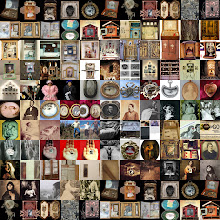This talk at the Whitechapel Gallery was part of Performing Medicine, a series of performances and events inspired by the theme of anatomy, bringing together artists, academics and doctors. ORLAN talked about her past sugery-performances, her present work that involves biomedicine, and her 'carnal art' manifesto. Here are some of my notes and quotes from the talk:
- She uses her body as battleground to create debate and question political, social and ethical issues. The 'ORLAN body' transgresses the cultural meanings it is inscribbed in, through her radical manipulation of it/herself.
- In her earlier work and in the staging of her operations, she draws from baroque aesthetics, perhaps more clearly seen in her photographs and character of 'Saint Orlan' which reminded me of Bernini's St Teresa, which in turn illustrates the cover of Georges Bataille's Eroticism.
- Recurrent themes in her work are feminism, identity politics, Intersexuality, Post-humanism, technologies, the cyborgian, and the hybrid.
- "This is my body, this is my software" to confront the political, ideological and religious pressures inscribbed in the body, and more particularly, in the female body.
Saint Orlan
Bernini's St Teresa
- The idea for broadcast surgery happened after she underwent emergency surgey for an ectopic pregnancy, and decided to take a film crew inside the operating theatre. She says she experienced the similarities between the operating theatre and the church, the hierarchical structure, the ceremonial, the solemnity...
- She mentioned Courbet's Origin du monde, and her response Origin du guerre. She humorously alluded to Courbet's subject being amputated and that she hoped she didn't suffer during the operation...
- About PAIN the Christian rejection of the body as pleasure, and the 'need' of the body to suffer, suffering to expiate, to redeem. The one rule she asked from the procedures was no pain.
- "The impossibility and madness of seing" an open body, a fear a seeing "that would make us mad"
- "Life as aesthetical material"
- The radical difference between performance and theatre, "Carrying out an action, not being an actor"
- She often read during her surgery-performances books like The Robe by lacanian psycoanalist Eugenie Lemoine-Luccioni, which talks about the SKIN as disappointing, and hiding reality; ORLAN uses today's technology to breach that gap between the external and the inner self.
- She is also inpired by Antonin Artaud's concept of the body without organs.
- It was really interesting seeing her talk about her relationship with surgeons, "some knew better than me what my body should look like", there was often rivalry because the surgeon is at the top-as creator, artist- of a pyramidal power structure, directing his servants to pass the tools... And ORLAN was precisely taking that rol.
-"The power of men over the female body can imprint itself through aesthetic surgery"
-"body that I have/body that I am"





